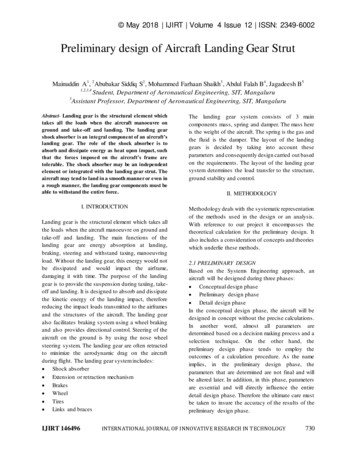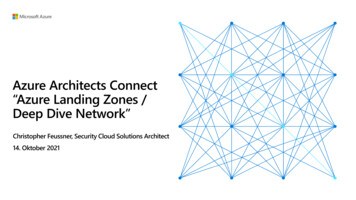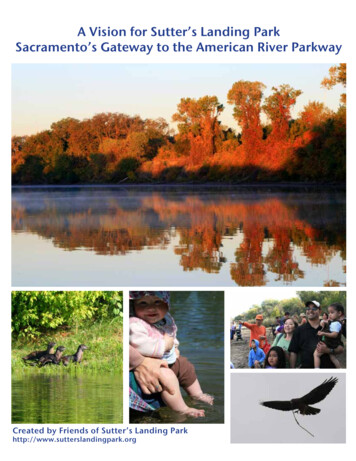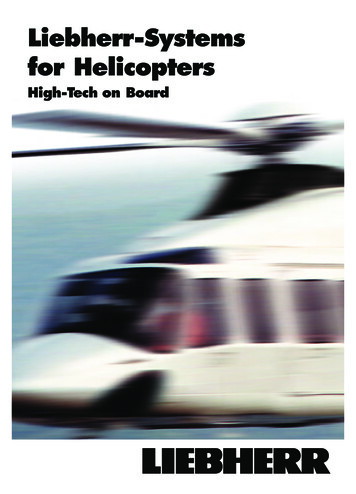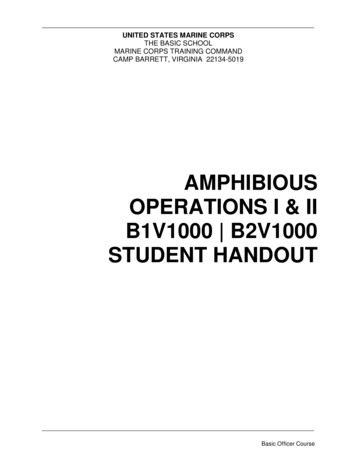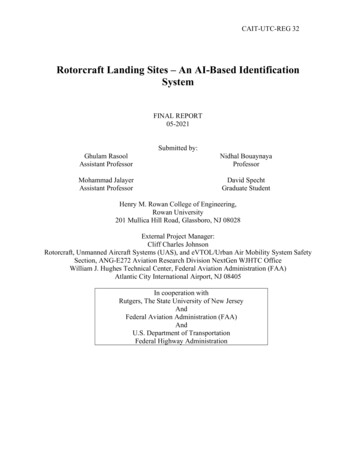
Transcription
CAIT-UTC-REG 32Rotorcraft Landing Sites – An AI-Based IdentificationSystemFINAL REPORT05-2021Ghulam RasoolAssistant ProfessorMohammad JalayerAssistant ProfessorSubmitted by:Nidhal BouaynayaProfessorDavid SpechtGraduate StudentHenry M. Rowan College of Engineering,Rowan University201 Mullica Hill Road, Glassboro, NJ 08028External Project Manager:Cliff Charles JohnsonRotorcraft, Unmanned Aircraft Systems (UAS), and eVTOL/Urban Air Mobility System SafetySection, ANG-E272 Aviation Research Division NextGen WJHTC OfficeWilliam J. Hughes Technical Center, Federal Aviation Administration (FAA)Atlantic City International Airport, NJ 08405In cooperation withRutgers, The State University of New JerseyAndFederal Aviation Administration (FAA)AndU.S. Department of TransportationFederal Highway Administration
Disclaimer StatementThe contents of this report reflect the views of the authors, who are responsible for the facts and the accuracyof the information presented herein. This document is disseminated under the sponsorship of theDepartment of Transportation, University Transportation Centers Program, in the interest of informationexchange. The U.S. Government assumes no liability for the contents or use thereof.The Center for Advanced Infrastructure and Transportation (CAIT) is a Regional UTC Consortium led byRutgers, The State University. Members of the consortium are Atlantic Cape Community College, ColumbiaUniversity, Cornell University, New Jersey Institute of Technology, Polytechnic University of Puerto Rico,Princeton University, Rowan University, SUNY - Farmingdale State College, and SUNY - University atBuffalo. The Center is funded by the U.S. Department of Transportation.
1. Report No.2. Government Accession No.3. Recipient’s Catalog No.CAIT-UTC-REG 324. Title and SubtitleRotorcraft Landing Sites – An AI-Based IdentificationSystem7. Author(s)Ghulam Rasool https://orcid.org/0000-0001-8551-0090,Nidhal Bouaynaya https://orcid.org/0000-0002-8833-8414,Mohammad Jalayer https://orcid.org/0000-0001-6059-3942,David Specht https://orcid.org/0000-0002-1894-20349. Performing Organization Name and AddressHenry M. Rowan College of Engineering, Rowan University,201 Mullica Hill Road, Glassboro, NJ 080285. Report Date02 / 20216. Performing Organization CodeCAIT/Rowan8. Performing Organization Report No.CAIT-UTC-REG 3210. Work Unit No.11. Contract or Grant No.69A355184710212. Sponsoring Agency Name and Address13. Type of Report and Period CoveredCenter for Advanced Infrastructure and TransportationRutgers, The State University of New Jersey100 Brett RoadPiscataway, NJ 0885414. Sponsoring Agency CodeFinal Report01/1/2020 – 12/31/202015. Supplementary NotesU.S. Department of Transportation/OST-R1200 New Jersey Avenue, SEWashington, DC 20590-000116. AbstractLocation data about U.S. heliports is often inaccurate or nonexistent in the FAA's databases,which leaves pilots and air ambulance operators with erroneous information about where to findsafe landing zones. In the 2018 FAA Reauthorization Act, Congress required the FAA to collectbetter information from the helicopter industry under part 157, which covers the construction,alteration, activation, and deactivation of airports and heliports. At the same time, there is norequirement to report private helipads to the FAA when constructed or removed, and somepublic heliports do not have up-to-date records. This project developed an autonomous systemthat can authenticate the coordinates present in the FAA master landing site database. Oursystem can search for helipads in designated large areas around the country. The proposedapproach is based on a convolutional neural network model that learns optimal helipad featuresfrom the data. We used the FAA's 5010 database and others to construct a benchmark databaseof rotorcraft landing sites. The database consists of 9,324 aerial images containing helipads,helistops, helidecks, and helicopter runways in rural and urban areas. The database also includesnegative examples, i.e., satellite images, e.g., rooftop of buildings and fields that are notdesignated landing sites. The dataset was used to train various state-of-the-art convolutionalneural network models (CNN). The outperforming model, EfficientNet-b0, achieved nearly95% validation accuracy.17. Key WordsHelipad, detection, machine learning, deepneural networks, aviation safety19. Security Classification (of this report)Unclassified18. Distribution Statement20. Security Classification (of this page)Unclassified21. No. of Pages3922. Price
AcknowledgementThe project team would like to express gratitude to the National University Transportation CenterConsortium led by Rutgers’ Center for Advanced Infrastructure and Transportation (CAIT) for theirgenerosity for this research project. The authors would also acknowledge the support provided byCliff Charles Johnson, the external project manager and stakeholder from William J. Hughes Tech nical Center, Federal Aviation Administration (FAA). Cliff was instrumental in the project’s con ception and provided multiple helipad datasets used for the training of machine learning algorithms.He regularly met with the team and guided the project at every stage.We would also like to thank LZControl for their guidance and assistance with this effort. Viaa Cooperative Research and Development Agreement with the FAA, LZControl provided a set ofdata from their system and subject matter expertise which provides landing zones for helicoptersacross the U.S., often complementing the FAA’s 5010 database and including locations/sites notpresent in the FAA’s 5010 system.4
Table of Contents123Introduction61.11.266Background and Motivation . . . . . . . . . . . . . . . . . . . . . . . . . . . . .Related Work . . . . . . . . . . . . . . . . . . . . . . . . . . . . . . . . . . . . .Convolutional Neural Networks (CNNs)82.12.289Learning Features with CNNs . . . . . . . . . . . . . . . . . . . . . . . . . . . .Interpreting and Explaining the Predictions of CNNs . . . . . . . . . . . . . . . .Rotorcraft Landing Site Dataset103.13.2Google Static Maps API . . . . . . . . . . . . . . . . . . . . . . . . . . . . . . . 11Building the Dataset . . . . . . . . . . . . . . . . . . . . . . . . . . . . . . . . . 123.33.2.1 Positive Examples . . . . . . . . . . . . . . . . . . . . . . . . . . . . . . 123.2.2 Negative Examples . . . . . . . . . . . . . . . . . . . . . . . . . . . . . . 13Final Benchmark Dataset for Training CNNs . . . . . . . . . . . . . . . . . . . . 134 Explainable Identification of Helipads144.1 Convolutional Neural Network Models . . . . . . . . . . . . . . . . . . . . . . . . 144.1.1 ResNet101 . . . . . . . . . . . . . . . . . . . . . . . . . . . . . . . . . . 144.1.24.1.34.1.4Inception V3 . . . . . . . . . . . . . . . . . . . . . . . . . . . . . . . . . 15Xception . . . . . . . . . . . . . . . . . . . . . . . . . . . . . . . . . . . 15EfficientNet b0 . . . . . . . . . . . . . . . . . . . . . . . . . . . . . . . . 155 Experimental Results156 Helipad Search in Large Areas166.1 Searching for Helipads in Large Areas . . . . . . . . . . . . . . . . . . . . . . . . 176.2 Searching for Helipads in Los Angeles . . . . . . . . . . . . . . . . . . . . . . . . 207 Conclusion20A Sample Results24A.1 True Positive Cases . . . . . . . . . . . . . . . . . . . . . . . . . . . . . . . . . . 24A.2 False Positive Cases . . . . . . . . . . . . . . . . . . . . . . . . . . . . . . . . . . 30A.3 False Negatives Cases . . . . . . . . . . . . . . . . . . . . . . . . . . . . . . . . . 365
11.1IntroductionBackground and MotivationAccurate information about the location and type of rotorcraft landing sites is an essential asset forthe Federal Aviation Administration (FAA) and the Department of Transportation (DOT). However,the acquisition, verification, and regular updating of information about these landing sites is achallenging task. The lack of reliable information on helipad sites is a risk factor in several accidentsand incidents involving rotorcrafts. The U.S. Helicopter Safety Team (USHST), of which the FAAis a key member, has identified and produced recommendations from their infrastructure workinggroup to modernize and improve “the collection, dissemination, and accuracy of heliport/helipadlanding sites” as a high priority to increase helicopter safety.There are thousands of landing locations for helicopters spread across the United States. Ingeneral, rotorcraft operators can get information about helipads, heliports, and landing sites usingvarious databases, such as the FAA’s 5010 database. However, it is also well known that the 5010database and similar databases contain multiple inaccuracies where some helipads in the databasemay no longer exist or their coordinates are imprecise, and other helipads are missing from thedatabase. The unreliability of this database is a consequence of the fact that there is no system toverify that coordinates remain accurate, nor is there a system to search for unreported helipads.In this project, we propose a machine learning solution to identify helipads, heliports, and otherlanding sites, from aerial imagery using convolution neural networks or CNNs. We built a com prehensive database by manually checking the FAA and other databases with satellite images fromGoogle Earth. We subsequently trained and validated different state of the art CNN models todetermine an appropriate machine learning model for this task.The proposed machine learning solution based on modern artificial intelligence (AI) techniqueswill allow the FAA and USDOT to automatically maintain an updated database of helipads, heli ports, and landing site infrastructure for the rotorcraft community. This work presents the first steptowards autonomous identification of specialized heliport infrastructure and can be optimized withminimal cost using Google Earth API. The results of this project will help the FAA and USDOTachieve the first strategic goal of “Improving durability and extending the life of infrastructure” byproviding an updated record of the infrastructure without committing additional resources for datacollection and recording.1.2Related WorkWe can group the literature of identifying helipads from satellite or aerial imagery into two mainapproaches. The first is a model based approach, which relies on domain expert knowledge to ex 6
tract features that can be used to identify helipads from images. A common feature used to identifyhelipads is the “H” marking [Prakash and Saravanan, 2016, Patruno et al., 2017]. For vision basedautonomous landing systems, an improved version of the Scale Invariant Feature Transform (SIFT),called Speeded Up Robust Features (SURF), was used in [Prakash and Saravanan, 2016] to performfeature points matching and tracking. Features points are compared to points in an “H” template todetermine the similarity of the template and the aerial image.In [Rungta et al., 2020], the detection process consists of finding candidate helipads based onthe following four properties: (1) a bold circle surrounding the “H”, (2) presence of “H” in a brightcolor inside this circle against a dark background, (3) “H” is centered at the center of the circle,and (4) intersection of diagonals of “H” at the center of the circle. A Hough transforms was usedto identify circles[Rungta et al., 2020]. Due to a large number of false positives, the authors usedthree tests to eliminate these false positives. None of these tests are precise and as a consequence,error ranges were added based on experiments. After a helipad has been detected, a Median Flowtracker [Zdenek Kalal, Krystian Mikolajczyk, and Jiri Matas, 2010] was used to track the region.A vision based helipad detection algorithm based on curvature was proposed by Patruno et al.[Patruno et al., 2017]. The method creates blobs of connected pixels, and exploits some intrinsicproperties of each blob, such as the location of its center of mass, the Euler number, the eccentricity,the perimeter, and the area, to identify the blobs which represent the helipad marks, namely thecharacter “H” and the circumscribing circles. The Euler number is an integer value defined asthe number of connected components minus the whole number. In particular, the Euler numberis equal to zero for circle blobs and one for “H” blobs. A final classification level checks theratios between the areas and perimeters of blobs against expected values. Following detection, anidentification step checks if the Euclidean distance of the centroids of the detected blobs and theratios of related areas and perimeters are still met [Patruno et al., 2017]. Once the helipad markshave been identified, the Canny edge detector is performed in order to extract the 12 corners of“H” edge. Instead of using feature extraction operators, such as the Hough transform and linefollowing algorithms, the authors used a radius of curvature for every 2 D point of “H” edge todetect the corners of interest. A big radius value denotes that the point is far from a corner while asmall value indicates that the point might be a possible candidate to be a corner. Three checks areperformed for all the possible corner candidates, based on the knowledge of “H” size and exploitingthe Euclidean distances between these points and the centroid of “H” contour.Although quite exhaustive, these model based detection algorithms have many restrictions.First, they were shown to work only in simple simulated environments and may fail in more com plex environments. Secondly, these algorithms have limited effectiveness at further distances andangles. Some of these issues were addressed in [Pierre et al., 2018], where the authors mainly re lied on flat ellipse detection as it is the most visible feature of a helipad seen from long distances.7
An adaption of the Hough transform was devised for the specific case of very flat ellipses. A vali dation step using many other properties and visual clues performs the verification of the presenceof the helicopter landing platform in the research areas delimited by the obtained ellipses.The main advantage of the model based approach is its explainability and its relatively goodperformance on small datasets with no prior labeling. However, while model based methods canidentify helipads that adhere to the recommended standard set in the FAA’s 150/5390 2C, neither thecircle nor the “H” is required for building a helipad. Model based methods will need to considerall possible features of all types of helipads/heliports, including those that do not adhere to therecommended standard, to generalize their performance [FAA, 2012].Data driven algorithms, on the other hand, involve the collection of large amounts of labeleddata, autonomously learning salient features from the raw data, and identifying helipads based onlearned features. As such, data driven systems can identify complex patterns of helipads that maybe hard to model. The price paid is the large data and computational resource requirements. To thebest of our knowledge, data driven approaches to identify helipads are under explored, despite thegrowing prevalence of learning systems in real world applications. Nonetheless, there are onlinesystems available.HelloPad is a system that uses a machine learning algorithm to identify helipads within a spec ified region [Walker, 2019]. The system uses a sliding window and a trained neural network model(ResNet) to identify if a helipad exists at a given location. HelloPad reported 67.2% precision and90% recall in a Los Angeles downtown area. However, HelloPad collected negative (non helipad)examples from urban settings, and will likely not transfer well to all areas of the U.S.2 Convolutional Neural Networks (CNNs)2.1Learning Features with CNNsObject detection and identification requires considerable domain expertise to design features thattransform the raw data (such as the pixel values of an image) into a lower dimensional representa tion that is discriminatory for the input. Convolutional Neural Networks (CNNs) are designed toprocess multidimensional data arrays, such as images, by automatically discovering the representa tions needed for detection or classification. There are three types of layers in a CNN: convolutionallayers, pooling layers, and fully connected layers. Each convolutional layer obtains, through con volutions followed by non linear operators, representations that are important for the classificationtask. A hierarchical composition of these representations (starting with the raw input), where eachrepresentation is fed to the next convolutional layer, leads to learned features that are optimal fordiscrimination. The first (convolutional) layers typically learn low level features, such as edges,8
and later layers extract more complex semantic features. The key aspect of CNNs is that theselayers of features are not designed by human engineers or domain experts: they are learned fromdata [LeCun et al., 2015].A problem with the output feature maps is that they are sensitive to the precise location of thefeatures in the input. This means that small variations in the position of the feature in the input imagewill result in a different feature map. One approach to address this sensitivity is to coarse grain theposition of each feature through down sampling, referred to as “local translation invariance”. Therole of pooling layers is to summarize the feature maps by down sampling, i.e., discarding the finerdetails that may not be useful to the task, creating an invariance to small shifts, while maintainingimportant structural elements. A typical pooling unit computes the maximum value for each patchof the feature map.Layers of convolutions, non linearities, and pooling are stacked to learn robust optimal featuresfor the data, followed by fully connected layers that form the classifier for the extracted features.Backpropagating gradients through a CNN is as simple as through a regular neural network, allow ing all the weights in all the filters to be trained.2.2Interpreting and Explaining the Predictions of CNNsWhile CNNs have achieved higher than human accuracy in many computer vision tasks, they pro vide little insight into computations that they perform to make these decisions or predictions. Withthe composition of convolutions, non lineariries, pooling and fully connected layers, very complexfunctions can be learned, making deep learning models black boxes. This poor interpretability sig nificantly hinders the robustness evaluation of the network, its further optimization, as well asunderstanding the network adaptability and transferability to different datasets. In the case of he lipad detection, this question becomes “Does the network detect salient features of helipads in theimage, or does it detect other features that typically correlate with the presence of a helipad?”. Anunderstanding of the learning process will allow for the identification of cases where the algorithmmight fail, and also build trust in learning systems to allow for their safe deployment.An intuitive approach to understand the inner workings of deep learning models (such as CNNs)is the gradient saliency map. This approach computes the gradient of the class score with respectto the input image; thus, highlighting the areas of the input image that are discriminative withrespect to the predicted class [Simonyan et al., 2014]. A popular gradient saliency method is theGradient weighted Class Activation Mapping (Grad CAM). Grad CAM uses the gradient infor mation flowing into the last convolutional layer of the CNN to assign importance values to eachneuron for a particular decision of interest [Selvaraju et al., 2019].In this project, Grad CAM provides a multifaceted advantage. First, the saliency map will be9
Figure 1: Sampling images from Google Earth for building datasets of positive (helipad is present)and negative examples (no helipad is present). The dataset will be used to train machine learningand AI models. The sampled area is enclosed in the black box. There is no helipad inside thesampled area (negative example). However, a helipad is present just outside the sampled area. Thearea containing helipad can be also be sampled as a positive example.able to verify that the network classifies imagery as helipads because of the presence of helipadsand not supporting facilities. Second, it can help with understanding and mitigating false positives,i.e., the non helipad samples classified as a helipad. Lastly, the saliency map can help locate thehelipad, which will allow for larger regions to be searched for helipads.3 Rotorcraft Landing Site DatasetWe acquired three datasets through the FAA, one dataset from the Iowa DOT website and onedataset from ArcGIS. These five datasets provide the longitude and latitude of potential helipadlanding locations. We used Google Earth’s API to extract the corresponding images as well asto sample negative helipad locations. We noticed some discrepancies in the FAA datasets andmanually curated the coordinates to ensure accuracy for our use cases. In the following, we willelaborate on each dataset, data cleaning approach, and our method for collecting negative samples(satellite images with no designated helipads or landing sites present). Figure 1 shows the samplingprocess for image collection for positive examples (a helipad is present in the satellite image) andnegative examples (helipad or landing site is not present in the image).10
3.1Google Static Maps APIWe used Google static maps API to collect satellite imagery of positive (helipad) and negative (non helipad) locations. The service is accessed by sending an HTTP request with a query containing thedesired parameters. The Google server responds with an image based on the provided parameters.The parameters used here are: center, zoom, the size, and maptype. The center provides the coordi nates of the center of the image. Zoom determines the zoom level, which defines the resolution ofthe current view. Size determines the number of pixels in the image. Maptype determines the typeof image to be retrieved (as Google maps contains road maps). For the purposes of this project,size was set to the maximum value of 640 640, and the maptype was always satellite. The centerwas set to the desired coordinates to be sampled for the image. The highest resolution images areavailable at a zoom of 20; however, a zoom of 18 was used instead. At zoom 20, some images didnot include the designated helipads as shown in Figure 1. The difference between the two zoomlevels can be seen in Figure 2. A lower zoom results in a larger area that will allow for samplinghelipads using fewer API calls. There is a cost associated with making API calls beyond a certainlimit, so efficiency of calls becomes important for scaling up the model to large areas.Figure 2: Zoom level in Google Map API. Left image is downloaded at the zoom level of 18 andthe right image at the zoom level of 20. At a zoom of 18, numerous possible parking pads and ahelipad are visible. The helipad is not visible at the zoom of 20.One major issue with the initial databases is the incorrect reporting of landing site coordinates.In our experiments, a coordinate was considered correct if there was a landing area present in theGoogle imagery taken of the area. This is to allow for a margin of error in the reported coordinates.The margin is considered acceptable as it is believed to be reasonable for a pilot to identify a helipad11
within the given area. However, there are few cases where helipads would be within a reasonablerange of the coordinates, yet not present within the imagery being sampled. Figure 1, shows a casewhere there is a helipad near the coordinates, however the helipad is outside the range that wasannotated. A lower zoom could be used to sample a larger area, however while this may still bewithin an acceptable margin of error, the markings on helipads become less noticeable.Another known issue is the recency of Google’s satellite imagery. The images used in Googlemaps are not real time images, but rather imagery taken during an area survey. This means thatthe overhead view that was sampled does not actually reflect the current state of the area. Googleattempts to keep the images up to date such that the available imagery should be less than threeyears old; yet this may still lead to inaccuracies in landing site locationsGoogle Maps maintain a database that covers most of the world; however, it does not containhigh resolution imagery for every coordinate in the world. Typically, at higher levels of zoom,there are fewer coordinates with available imagery. Even when using a zoom of 18, there are a fewcoordinates that simply did not have the imagery available. If a zoom of 20 were used, there wouldlikely be fewer locations from where images could be downloaded.3.23.2.1Building the DatasetPositive ExamplesAreas with helipads are needed to create a positive dataset for the training of the machine learningmodel. While areas can be randomly sampled using Google Maps API and helipads in those areaslabeled, this would be an incredibly inefficient process. There is an extremely low probability thata randomly sampled location would contain a helipad. We used the initial FAA, IOWA DOT, andArcGIS helipad datasets to sample positive areas, The FAA’s 5010 was the largest database. Toensure accuracy, all coordinates were manually annotated so that only coordinates where a heli pad would be visible in the collected image was added to the training set. From an initial 6, 333coordinates in the dataset, only 3, 887 were manually annotated to be helipads. An additional 157positive coordinates were added from other databases provided by the FAA, including the Lifeflightof Maine datasetTwo publicly available datasets were used. The first is a dataset found on ArcGIS containingthe coordinates of hospital helipads found in California. This dataset contained 170 coordinates,and after annotation, 169 of these coordinates were used. The second is Iowa DOT’s dataset, whichlisted 126 locations, and 111 of these coordinates were considered to contain helipads.12
3.2.2Negative ExamplesA negative (non helipad) set of images is also needed to train the machine learning model. Thenegative set was collected using random sampling of Google Maps. These random samples weremanually checked to ensure that they did not contain any landing site. As the current goal is toidentify helipads in the U.S., the sampling was limited to an area such that the sampling regionincludes most of the mainland U.S. However, most of these samples were of forested areas andfarmlands and contained very few urban areas. This could bias the network to predict helipadsmainly in urban areas It is therefore important to sample negative locations from urban areas aswell. It is noted that urban areas will likely have a higher helipad density, and thus a helipad willbe more likely to be found there. To lessen this risk, locations like Washington D.C. and New YorkCity were chosen due to the lower density of helipads. In New York City, ownership of rooftophelipads became more restricted after the 1977 crash at the Pan Am building, along with noisecomplaints continuing to restrict helicopter flights. Washington D.C. is in restricted airspace andallows only a few helipads to operate.3.3Final Benchmark Dataset for Training CNNsAfter careful data collection, labeling, and organization, a helipad identification benchmark datasetwas created. The positive set contains 4, 324 samples. Some areas are more represented than others,as some of the datasets used were specific to certain regions. However, the largest dataset makingup over 80% of the final dataset is the FAA’s dataset spread over the United States and its territoriescovering different types of landing areas, including helicopter parking pads, helidecks, EmergencyHelicopter Landing Facilities (EHLFs), and heliports.The negative set was created by randomly sampling 5,000 coordinates. A total of 2,000 ofthese coordinates were from the mainland United States and contained woodland and other ruralareas. The remaining 3,000 negative images were sampled from urban areas, such as San Jose,Washington D.C., New York City, and San Antonio.The final benchmark dataset has 9, 324 satellite images labeled as either helipad or non helipad.Figure 3 shows some of the images in the dataset. On the left, we show some landing locations,including helistops, helidecks, and helicopter runways. On the right, we present some randomlysampled imagery including rural and urban areas. It is noteworthy to mention the variety of landingsites shown in Figure 3. In particular helipads have different sizes, as their minimum requiredlengths are decided by the rotor diameter of helicopters intended to land. This causes the areas theyrepresent in squared meters to be different. Other factors, such as the zoom level which takes intoaccount the distance from the satellite, the elevation, and the latitude add to the complexity of thelanding sites imagery.13
Figure 3: Sample aerial images from the dataset that we developed as a part of the project. Whilethe term helipad is used for the positive set, the dataset also contains areas that helicopters areintended to land at, e.g., helicopter runways.44.1Explainable Identification of HelipadsConvolutional Neural Network ModelsWe considered four different CNN models for the helipad detection task. These included ResNet101,Inception, Xception, and EfficienetNet B0 [Tan and Le, 2019, He et al., 2016] [Szegedy et al., 2016,Chollet, 2017]. These models were chosen as they represent a variety of families of common CNNarchitectures. The details of the these models are presented in Table 1. All of these models servedas feature extractors with additional layers for fine tuning and classification as shown in Figure 4.Table 1: Comparison of select
Henry M. Rowan College of Engineering, Rowan University, 201 Mullica Hill Road, Glassboro, NJ 08028 10. Work Unit No. 11. Contract or Grant No. 69A3551847102 12. Sponsoring Agency Name and Address 13. Type of Report and Period Covered Final Report 01/1/2020 - 12/31/2020 Rutgers, The State 14. Sponsoring Agency Code 15. Supplementary Notes

